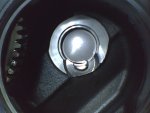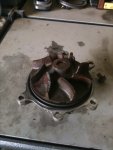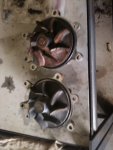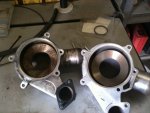So I started to give this some thought. The second pump failed at the NHRDA finals in Boise in Oct. The temps that day were in the 40-50's and windy. I know the coolant temps never got up past 180 degrees before I wnet down the drag strip.
I believe the themstats were not opening at those temps, causing a major pressure backup which strained the pump as it was trying to push water through a dead headed system.
I did a bit of searching on the internet and found this;
Duramax dual thermostat and cooling system description and operation
Thermostats -6.6L Duramax Diesel Engine
Thermostats are coolant flow control components. The function of the thermostats is to regulate the correct operating temperature of the engine. Thermostats utilize a temperature sensitive wax-pellet element. The element connects to a valve through a piston. When the element is heated, it expands and exerts pressure against a rubber piston. This pressure forces the valve to open. As the element is cooled, it contracts. This contraction allows a spring to push the valve close.
The 6.6L diesel engine requires two thermostats for correct coolant flow. The front thermostat is a dual purpose thermostat. The front thermostat controls the coolant flow to the bypass port and to the water outlet which leads to the radiator. The rear thermostat only controls the coolant flow to the water outlet.
When the coolant temperature is cooler than the rated thermostat opening temperature the front thermostat valve remains closed to the water outlet (upper rad. hose)and is opened to the bypass port. So the bottom portion of the thermostat is raised off of the bypass port while at the same time the top portion closes the coolant flow to the radiator. The rear thermostat also is closed to the water outlet during engine warm-up. This prevents circulation of the coolant to the radiator and allows the engine to warm up quickly. After the coolant temperature reaches 82°C (180°F) the front thermostat primary valve opening temperature, the front thermostat primary valve will start to open. The coolant is then allowed to circulate through the thermostat and housing and into the radiator where the engine heat is dissipated to the atmosphere. As the engine coolant reaches 85°C (185°F) and more coolant demand is required the front thermostat secondary valve begins to close the bypass port and the rear thermostat begins to open and allows coolant to flow to the water outlet. The thermostats will continue to control the coolant flow by opening and closing. The front thermostat will be fully open when the coolant temperature reaches 95°C (203°F) the rear thermostat will be fully open when the coolant temperature reaches 100°C (212°F). The thermostats also provide a restriction in the cooling system, even after it has opened. This restriction creates a pressure difference which prevents cavitation at the water pump and forces coolant to circulate through the engine block. This data on temperatures is exclusive to factory supplied thermostats. It does not reflect temperature variations from higher rated thermostats.
So now to figure out how to do away with the restiction on cold days with short notice calls to the lanes, still warm up the engine enough for saftey and good performance without a lot of idling. Early opening themostats would help(do they make any?)or removing the themostats completely and install restrictors(I may test this to see how warm-up is and how long).
Thoughts?





